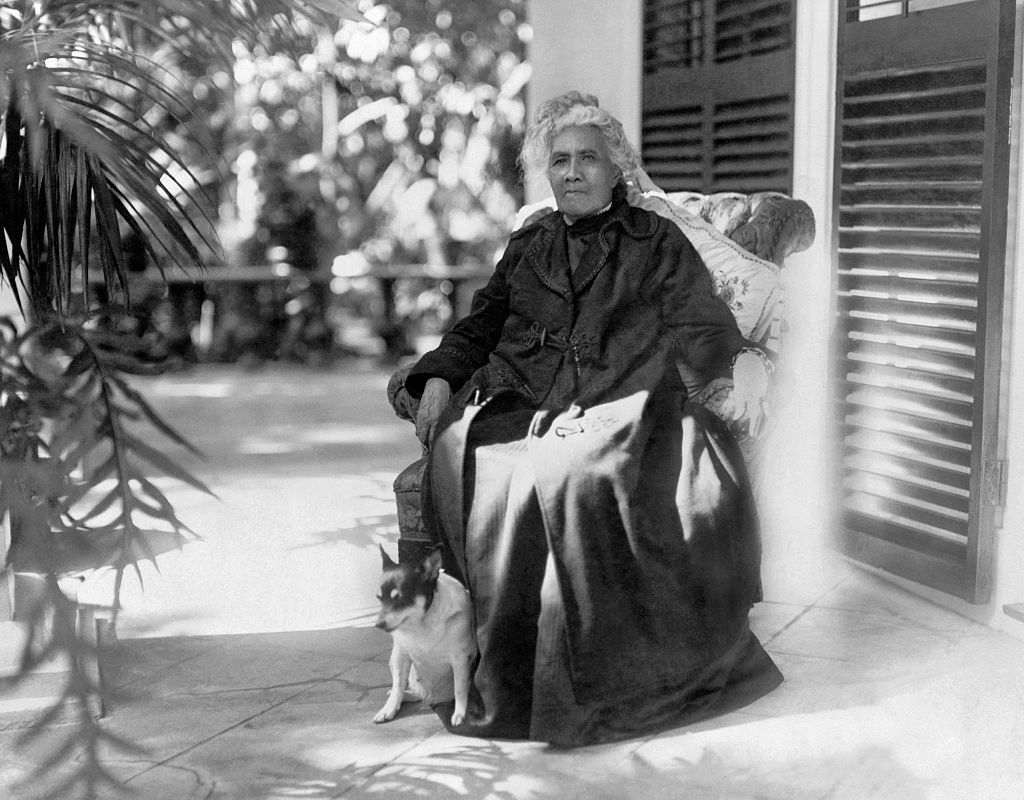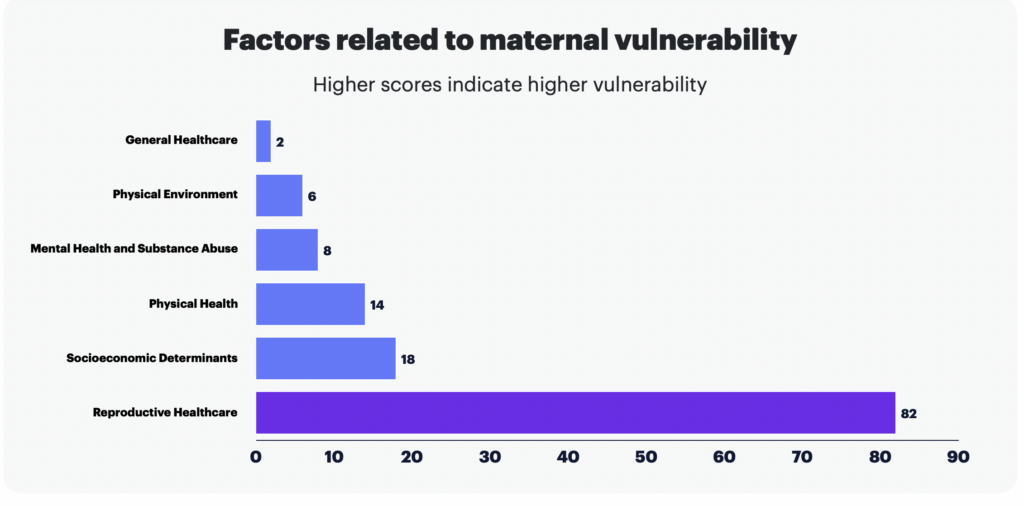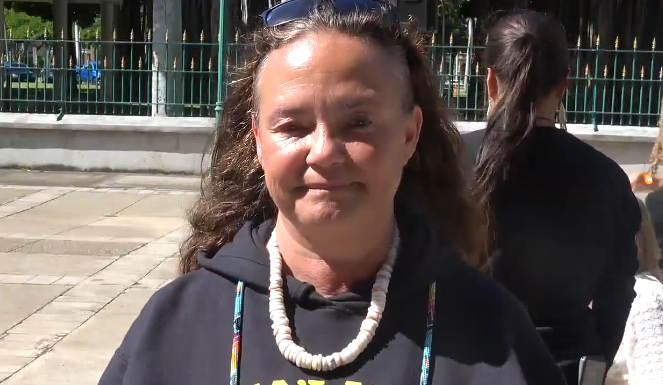Initially handed within the title of maternal and toddler security, Hawai‘i’s Midwifery Restriction Legislation is the topic of impassioned protests and a lawsuit introduced on behalf of 9 plaintiffs.

“Aloha, my title is Alia Stenback, and I’m an outlaw grandma. My legal offense was catching my grandson.”
Two days after Alia Louise Stenback survived the Aug. 8, 2023, wildfire in Lāhainā, Maui—the deadliest wildfire the USA has seen in over 100 years—she parked herself at a medical tent. One month later, with no ambulances round to offer transport to a hospital, her grandson was born. With a donated birthing equipment and the assist of conventional midwives, Stenback “caught [her] grandson.” (Notably, many midwives, doulas and conventional start practitioners consider the mom or birthing particular person “delivers” the child—the helpers merely “catch” it.)
Stenback grants herself “outlaw” standing as a result of she offered care throughout labor with no midwifery license, in assumed violation of Hawai‘i’s HRS §457J, in any other case referred to as the Midwifery Restriction Legislation. Handed in 2019, the legislation prohibits anybody who doesn’t have a state-issued license from training “midwifery,” broadly outlined as offering recommendation, supervision or care throughout being pregnant, start or the postpartum interval. The legislation allowed a “grace interval”; unlicensed start attendants had till July 1, 2023, to achieve mandatory certification. Many by no means did—and now concern legal penalties.
A few of those that stay unlicensed are these like Stenback, grandmothers or prolonged relations for whom the legislation makes no exception. Certainly, a clarification letter from the legal professional basic of Hawai‘i revealed final month that even when no cash exchanges fingers, solely state-licensed midwives or instant relations can provide “midwifery” assist, as outlined by the legislation throughout being pregnant, start or its aftermath.
Others who stay unlicensed work as pale keiki, a midwife who makes use of centuries-old Native Hawaiian birthing practices, or kahuna lāʻau lapa‘au, a conventional medicinal healer. Pale keiki and kahuna lāʻau lapa‘au could practice via apprenticeship, receiving inherited knowledge and conventional coaching from different practitioners. But, the Midwifery Restriction Legislation doesn’t acknowledge one of these apprenticeship as a correct foundation for state-issued licenses.
The legislation’s midwifery licensing scheme has solely produced 29 licensed midwives. None are Native Hawaiian, and many don’t even observe in Hawai‘i, which leaves pregnant residents of Hawai‘i with out authorized choices for conventional care from Native practitioners.
Midwifery Restriction in Hawai‘i
The Midwifery Restriction Legislation finds itself on the middle of layered controversy about Native Hawaiian sovereignty, maternal well being and reproductive autonomy (the correct to decide on the place and with whom to offer start). Initially handed within the title of maternal and toddler security, the legislation is the topic of impassioned protests, new legislative proposals and a lawsuit filed by the Heart for Reproductive Rights and the Native Hawaiian Authorized Company.
When Hawai‘i used to be nonetheless an unbiased nation—earlier than Queen Liliʻuokalani’s reign over the Hawaiian kingdom was minimize quick by a white-settler-led coup in 1895—Native Hawaiian therapeutic practices have been handed freely from era to era.

Shortly after the U.S.’ 1898 annexation of the islands, the U.S.-installed territorial authorities banned Native therapeutic customs, together with birthing practices.
In 1941, the identical authorities determined that solely licensed nurse midwives may observe midwifery, mimicking the coverage in lots of states all through the continental U.S. that pushed non-white practitioners out of midwifery (by excluding them from the coaching establishments required for certification).
After Hawai‘i grew to become the fiftieth state, a Hawaiian cultural renaissance started, and Native Hawaiians began reintegrating and reclaiming the cultural traditions colonialization pushed underground.
In 1978, residents of Hawai‘i voted to approve an modification to the state Structure, now Article XII, Part 7, promising that the state “shall defend all rights, usually and historically exercised for subsistence, cultural and spiritual functions” of Native Hawaiians “topic to the correct of the State to control such rights.”
In 1998, the state of Hawai‘i repealed the licensure mandate for midwives. For the subsequent 24 years, conventional midwives may observe and practice others overtly.
The Midwifery Restriction Legislation
The Midwifery Restriction Legislation’s said findings and goal present that Hawai‘i legislators regulated midwifery as a result of, they wrote, the “improper observe of midwifery” may result in “important danger of hurt to the mom or new child, and will lead to dying.” Certainly, main as much as the legislation’s passage, lawmakers heard testimony from organizations of involved practitioners; the Hawai‘i department of The American Faculty of Obstetricians and Gynecologists (ACOG), as an example, strongly supported the legislation’s licensing scheme as a result of they favor requirements for all maternity care. Despite the fact that lawmakers heard testimony from teams involved that the legislation’s broad definition of midwifery would limit conventional and cultural practices, they handed it with out substantial edits.
The legislation’s three-year “grace interval” exempting “start attendants,” unlicensed people who present assist or care throughout being pregnant, start or postpartum, meant to not solely permit start attendants to get licenses when mandatory but additionally give the legislature time to, within the legislation’s phrases, “enact statutes that may incorporate all start practitioners and permit them to observe to the fullest extent beneath the legislation.”
Six months earlier than the exemption expired, a state consultant launched HB 955, a invoice that may have prolonged the exemption—permitting conventional midwives and others to proceed training—and would have reopened a extra conventional, apprenticeship-based pathway to licensure. The invoice stalled within the Home Finance Committee, the place the chair, Rep. Kyle Yamashita, continues to deny HB 955 a listening to.
Below the present Midwifery Restriction Legislation, acquiring a midwifery license falls beneath a couple of paths.
- With a purpose to receive a license, one should show to the Hawai‘i Division of Commerce and Shopper Affairs that they’re both a “licensed midwife” (CM) or a “licensed skilled midwife” (CPM). CMs and CPMs are categorised as “direct-entry midwives”; in contrast to nurse-midwives, their coaching offers for non-hospital settings. There are presently no CMs working in Hawai‘i.
- The one different pathway to licensure is thru the Board of Nursing, which isn’t coated by the Midwifery Restriction Legislation, however that highway is just open to these skilled as a “licensed nurse-midwife” (CNM).
Usually, to turn out to be a CPM, a pupil midwife may match as an apprentice for a credentialed midwife or attend a college acknowledged by the Midwifery Schooling Accreditation Council (MEAC). There are solely eight MEAC establishments in the USA, and none are positioned in Hawai‘i. 4 packages supply fully distant programs, however they require cash and Wi-Fi, each of which could be prohibitive.
Home Invoice 955
With the start attendant gone, these giving start in Hawai‘i do not need an choice to work with a Native Hawaiian midwife (not one of the 29 CPMs licensed beneath this legislation are Indigenous and acquainted with conventional birthing customs). HB 955 would permit conventional midwives to maintain working, and by reopening the apprenticeship path to CPM credentials, it will grant extra midwives a path to licensure.
In response to the Honolulu Civil Beat, HB 955 acquired important assist simply inside three months of its introduction; lawmakers acquired testimony from “lots of,” together with the Hawai‘i State Fee on the Standing of Ladies, which known as the 2019 Midwifery Restriction Legislation “an overcorrection for public security.” The fee wrote that the legislation uncared for to bear in mind that “[t]he battle for ‘my physique, my alternative’ ought to prolong to a lady’s resolution the place and methods to give start and entry to extra concerned care, particularly in gentle of unfavourable outcomes linked to medical sexism and racism in the USA.”
HB 955 would permit conventional midwives to maintain working and … would grant extra midwives a path to licensure.
However ACOG, some physicians and a few midwives with state-issued licenses oppose HB 955, and legislators are following their lead. Notably, a few of these opponents, like Le‘a Minton, president of the Midwives Alliance of Hawai‘i, consider that start attendants and cultural practitioners can nonetheless observe beneath the Midwifery Restriction Legislation. Final month, the legal professional basic confirmed that each one start attendants are banned from training after July 1, 2023. Anybody who practices midwifery as outlined by the legislation with no license grew to become topic to fines as much as $2,000 and imprisonment for a most of 1 12 months.
Preventing the Midwifery Restriction Legislation
Now, over eight months later, conventional midwives are taking to the courts.
On Feb. 27, the Heart for Reproductive Rights (CRR) and the Native Hawaiian Authorized Company filed a criticism in state court docket difficult Hawai‘i’s Midwifery Restriction Legislation. Hillary Schneller, a senior workers legal professional at CRR, mentioned, “The legislation has had a extremely devastating influence specifically on Native Hawaiian midwives and households of coloration, actually stopping pregnant folks in Hawai‘i from utilizing expert midwives for his or her pregnancies and start.”
The case includes 9 plaintiffs: midwives who present conventional and culturally knowledgeable care (licensed and unlicensed), their college students and Native Hawaiian ladies who used or wish to use conventional midwifery companies throughout being pregnant, start and the postpartum interval. The criticism alleges that the Midwifery Restriction Legislation interferes with the plaintiffs’ state constitutional rights, violating provisions associated to the safety of Native Hawaiian customs and reproductive autonomy and is impermissibly broad.
“The legislation could have had good intentions,” Schneller mentioned, and “there are enhancements that may be made to the legislation, [but] within the meantime, it’s inflicting unbelievable hurt. So we’ve requested the court docket to dam the penalties beneath the legislation towards our shoppers who’ve been serving their communities in Hawai‘i for years.”
One in all their shoppers is Ki‘inaniokalani Kaho‘ohanohano, a Native Hawaiian pale keiki who engaged in conventional birthing practices for twenty years earlier than the Midwifery Restriction Legislation’s exemption expired. In a press launch from the Native Hawaiian Authorized Company (NHLC), Kaho‘ohanohano mentioned the legislation “is robbing the subsequent era of Native Hawaiians of our personal ancestral therapeutic data and energy.”
Reducing off our potential to take care of our households with our personal traditions and practices is medical colonialism.
Ki‘inaniokalani Kaho‘ohanohano
To the folks Kaho‘ohanohano serves, dwelling births permit them to “reclaim and perpetuate sacred and cultural practices,” because the criticism says.
Typically, it might probably additionally make them really feel safer. “Our communities are experiencing a maternal well being disaster in hospitals,” she mentioned within the press launch, “and chopping off our potential to take care of our households with our personal traditions and practices is medical colonialism.”
Being pregnant and Delivery within the U.S. and Hawai‘i
Native Hawaiians and different Pacific Islanders are 4.5 instances extra prone to die from pregnancy-related causes than their white counterparts, based on CDC knowledge from 2017 to 2019. In Hawai‘i particularly, though Native Hawaiians and Pacific Islanders comprise 22 p.c of the inhabitants of Hawai‘i, they account for 44 p.c of Hawai‘i’s pregnancy-related deaths.
In the USA typically, 98.4 p.c of births happen in hospitals. The numbers in Hawai‘i look the identical: in 2017 and 2018, the 2 years earlier than the Midwifery Restriction Legislation was handed, solely round 1.7 p.c of births have been deliberate dwelling births. None of them resulted in maternal or toddler deaths.
Most births in Hawai‘i throughout that point occurred in hospitals, the place medical intervention throughout start is frequent. Because the criticism explains, medical interventions—from episiotomies to cesarean sections—are sometimes mandatory. However when pointless, start interventions can elevate the chance of issues throughout supply. Citing a Hawai‘i State Division of Well being truth sheet, the criticism explains {that a} cesarean part, as an example, “is the most typical main surgical procedure carried out in the USA and ends in greater prices, longer hospitalization and elevated dangers of maternal morbidity in comparison with ladies who ship vaginally.”

Some ladies and others who give start discover that they lack a voice within the hospital context. Ezinne Dawson, one other one of many 9 plaintiffs within the swimsuit towards the Midwifery Restriction Legislation, mentioned within the NHLC press launch that she “went via three anxious and disempowering hospital births, so for [her] fourth baby, [she] determined to do a house start.”
Reviews counsel that mistreatment throughout being pregnant and start in hospital methods is significantly acute for Indigenous ladies and girls of coloration. In response to the criticism, Dawson—one of many state’s two licensed Black midwives, and one who trains others by way of apprenticeship—goals to “diversify the midwifery occupation” and advance maternal well being for marginalized sufferers.
ACOG and different doctor organizations that proceed supporting the Midwifery Restriction Legislation preserve {that a} hospital setting is the most secure for supply. However, because the lawsuit explains, Hawaiians dwelling in rural areas are sometimes removed from hospitals; all of O’ahu’s 5 hospitals which have labor and supply models are on the south of the island, round an hour-long drive from these dwelling on the north aspect. The one hospital on Maui is a two to a few hour automotive trip from the japanese aspect of the island.
The criticism says that typically, “pregnant folks give start on the aspect of the highway, en path to the hospital” due to vacationer congestion on the one “winding highway” out there.
These on different islands face related or extra boundaries. There is no such thing as a hospital with a labor and supply unit on Lāna‘i, which forces all of its pregnant residents to fly to a different island that would present care to be able to give start in a hospital or start middle. The criticism explains that people who can not make it to a hospital—or don’t wish to go to a hospital—flip to native midwives or prolonged household, any of whom may face legal penalties beneath the present legislation.
Taking Motion to Shield Reproductive Autonomy
The alternatives on the middle of this case, Schneller mentioned, are about reproductive autonomy.
“I feel folks connect with that abortion is a matter of reproductive rights,” she mentioned, “however it’s also very a lot in regards to the potential to make different choices throughout being pregnant and start … and piecing that each one collectively as a part of a sturdy proper to reproductive autonomy is crucial.”
On Feb. 29, two days after the criticism was filed, a gaggle related to the Pacific Delivery Collective gathered on the state Capitol for a press convention in regards to the lawsuit. Livestreamed on Fb, the occasion featured deliberate and unplanned audio system, from the top of the Hawai‘i ACLU and a former state senator, to aspiring conventional midwives and males who helped their companions via dwelling births.

They spoke about private experiences with Indigenous birthing practices, which had been misplaced for many years, and the significance of the correct to decide on the place and with whom to offer start. All of the whereas, they stood in entrance of a statue of the final Hawai‘ian queen.
Because the press convention drew to an in depth—as they began shifting to drop off copies of the not too long ago filed criticism into the fingers of state representatives—Alia Stenback got here to the digicam to talk about the start of her grandson, who wouldn’t be alive with out unlicensed start attendants, together with herself.
“I’m an outlaw grandma,” she mentioned, “I caught my grandson.”
Up subsequent:
U.S. democracy is at a harmful inflection level—from the demise of abortion rights, to an absence of pay fairness and parental depart, to skyrocketing maternal mortality, and assaults on trans well being. Left unchecked, these crises will result in wider gaps in political participation and illustration. For 50 years, Ms. has been forging feminist journalism—reporting, rebelling and truth-telling from the front-lines, championing the Equal Rights Modification, and centering the tales of these most impacted. With all that’s at stake for equality, we’re redoubling our dedication for the subsequent 50 years. In flip, we want your assist, Help Ms. immediately with a donation—any quantity that’s significant to you. For as little as $5 every month, you’ll obtain the print journal together with our e-newsletters, motion alerts, and invites to Ms. Studios occasions and podcasts. We’re grateful on your loyalty and ferocity.


